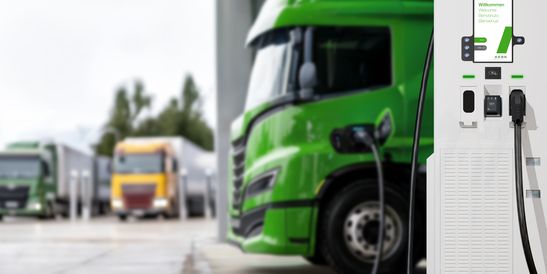How long does it take to charge an EV?
- Knowledge
- Private
- Charging
- 9.12.2021
- Reading Time: {{readingTime}} min

Contents

Vehicle type
Different vehicle models can charge at different rates. This is due to the respective components: the integrated charging station (the so-called on-board charger), the actual battery cells and their composition and chemistry, the battery management system, and the software. Some e-cars can be charged with alternating current (AC) with up to 22 kW, most with 11 kW, and still others with only 7.4 kW or even 3.6 kW, depending on the grid. With direct current (DC), the range is even wider, somewhere between less than 50 kW and more than 350 kW of temporary peak power.
State of charge
Especially with DC rapid charging, the charging process is not constant. A vehicle with 100 kW of maximum charging capacity would not charge with 100 kW at all times. Depending on the state of charge (SoC), the actual value is sometimes slightly lower and sometimes significantly lower. Even if there are big differences among vehicle types, the charging curves are generally similar: A completely discharged battery charges slowly at first, picks up speed at about 10% before charging at a high volume over a wider range (sweet spot), and finally the curve flattens considerably at about 80%. Why is that? Figuratively speaking, the battery is a like a container you fill with water that must not overflow. At first, you can pour the water liberally, but toward the end you must be more careful. Therefore, on long trips, several shorter recharging stops with between 20% and 80% SoC are more efficient than one long stop, for example. AC chargers, however, have an almost constant charging curve at comparatively low charging rates. They don’t have a real sweet spot.
Battery size
The bigger the “container” of the battery, the quicker it can recharge larger amounts in shorter periods of time—the last drops don’t really matter. It is true that a larger battery takes longer to fully recharge (from 0 to 100% SoC) than a smaller one of the same type at the same charging capacity. But because the charging curve stays up longer, a wider range can be recharged in the same amount of time. Here’s an example: Two e-cars of the same type, one with a battery capacity of 50 kWh, the other with 100 kWh, charge for 30 minutes at the same rapid-charging station, which allows for a maximum of 100 kW. Both cars start at 20% SoC. While the smaller battery reaches a range in which the performance levels off significantly, the large battery can remain close to its performance peak throughout. Why? It is not fully charged for a longer period of time, and that’s an advantage in this case. The result: The car with the larger battery charges a wider range in less time—and therefore charges faster in practice.
Charging point
In principle, a higher charging capacity leads to shorter charging times. If you have the time—and this is especially true when charging at home in your own garage—the charging capacity becomes secondary. Then the following rule applies: the slower, the better for the battery. That’s why some e-car drivers deliberately reduce the power input whenever they’re not pressed for time. In theory, AC at home allows for a performance spectrum of slightly above zero to 22 kW, and DC rapid chargers on the road allow for between 50 kW and currently more than 350 kW.
Temperature
Extreme and especially sub-zero temperatures are hard on the battery. Particularly in winter a modern e-car’s active temperature management must first preheat the battery cells before the usual charging speeds are possible. But here too, reduced charging performance is expected initially, primarily when rapid-charging with direct current. Charging at your wallbox at home does not put as much cold-related strain on the battery.
How to calculate the approximate charging time
When charging with alternating current, you can simply divide the battery size by the charging capacity to get a reliable charging time in hours. For example:
55 kWh / 11 kW = 5 h
The same formula generally applies to DC rapid charging, but it’s not as easy to determine the performance, as it is not constant. So, you have to use an average performance. If it’s kW, for example, the vehicle with 55 kWh battery size would charge from 0 to 100% SoC in
55 kWh / 70 kW = 0,79 h (47 min)
In reality, an electric car is rarely driven until the battery is completely empty and rarely sees a complete recharge. That’s why a calculation from 10 to 80% SoC is more informative. In this range, the average charging performance would definitely be higher (e.g. 100 kW). That would amount to a charging time of
38 kWh (70%) / 100 kW = 0,38 h (23 min)
and thus, less than half the time needed for a full recharge with only 30% less range gain. Since most drivers only rarely push the limits of their BEV’s range and usually charge at home when the vehicle is parked, the charging time is irrelevant in most cases. More important is the safety factor, which a wallbox is especially fit to provide.







